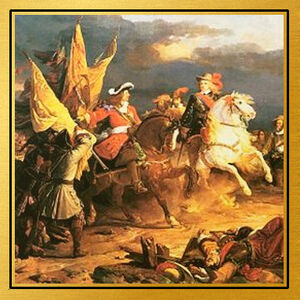| Age of Absolutism | |
| Period | Early Modern Ages |
| Dates | 1702-1756 AD |
| Chronology | |
| Preceded by Age of Louis xiv |
Followed by End of the Early Modern Age |
| “ | Everything for the people, nothing by the people. | ” |
–Joseph II Habsburg of Austria | ||
The era of the Age of Absolutism lasted from about 1696 AD until 1756 AD. It began on the eve of the War of Spanish Succession, the second of a series of major upheavals in the European balance of power. It then ended eve of the Industrial Revolution and the Seven Years’ War, two major turning points of history.
The Spanish War of Succession was very different from all previous Eropean conflicts. It was truly a world war, the first of the modern era, about the fate of the Spanish empire as well as about French power.
The 18th-century saw new lines of alliance and hostility that reflected changing realities of power. During the 16th and 17th centuries, the major line of antagonism in Europe was hostility between France and the Habsburgs, which had led to the Italy Wars, and Catholic France siding with Protestants in the Thirty Years' War, As British colonial holdings expanded during the 17th and early-18th centuries, however, France worried increasingly about British power, while Britain worried about France, which Louis XIV had made the strongest and wealthiest country in Europe. The Austrian Habsburgs remained the strongest power in central Europe, but, during the 17th, they were increasingly worried about the rise of Prussia, which under under Frederick the Great.established an enormous and well-disciplined army. Russia, which had played little role Europe during the 16th and 17th centuries, was also worried about Prussia, and, under Peter the Great, had expansionary plans of its own.
With the emergence of France under Louis XIV as the dominant political and cultural power in Europe, the European balance of power came into full effect. When king Charles II of Spain died without a heir, and the Spanish throne was left to a grandson of Louis XIV, the result was the Spanish War of Succession pitting France against a grand alliance of most of Europe. When the dust settled, a settlement was reached that ultimately left no one completely satisfied but kept the balance of power in place. The war characterised many of the conflicts throughout the 18th-century, constantly shifting alliances to prevent the hegemony of one nation or alliance. Another change in the balance of power was the gradual emergence of Prussia as a great power under Frederick the Great. His reign would be a blueprint for the ideas of an Enlightened Absolute Monarchy; a moderniser, a reformer, and militarily aggressive. Frederick would demonstrate his military genius and the prowess of the Prussian army in the War of Austrian Successions.
In the east, another autocratic ruler, Peter the Great, was transforming Russia based on the latest Western models, molding Russia into an absolutist state. It became recognized as a great power after defeating Sweden in the Great Northern War, securing Russian access to Baltic, and founding his new capital of St Petersburg. Never perhaps has a ruler so rapidly and ruthlessly transformed a backward society. On the opposite end of the political spectrum, Britain emerged from a second tense struggle for political power, the Glorious Revolution, as a Parliamentary Monarchy with a representative government. It was not democratic in a modern sense - barely 4% of the wealthiest British citizens were eligible to vote - but more people had a say in how their country was governed than any other European country, except perhaps the Dutch Republic.
History[]
Age of Absolutism[]
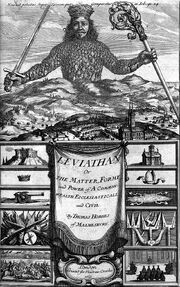
The title page of Thomas Hobbes’s Leviathan. a political treatise arguing the need for an authoritarian, unchallengeable ruler. The top half shows a huge crowned king, with a sword in one hand and a bishop’s staff in the other, rising above his realm, while the bottom shows various symbols of secular and sacred power.
In 1678, Jacques Bénigne Bossuet (d. 1704), court theologian to Louis XIV of France, and tutor to the king’s eldest son, wrote an instruction book for his royal charge; "Royal authority comes from God ... the prince must be obeyed as a matter of religion and of conscience ... the prince need render account to no one for what he orders". Bossuet was explaining, in terms even a boy could understand, the prevailing political theory of absolutism. Nearly everywhere there was an acceptance that, provided the monarchy was in the right hands, there should be no restriction upon its power. This was a fundamental break from the thinking of the past. To a medieval man the idea that there might not be ancient privileges and fundamental rights which would always be respected, or laws of God which could never be contravened by man, would have been political and theological blasphemy. In the 18th century, from Spain to Russia, rulers attempted to emulate the French model and make absolute royal authority a reality, imposing their will through decrees, limiting the powers of privileged groups, and building palaces modelled on Versailles. The Habsburg rulers of Austria built the palace of Schönbrunn outside Vienna (begun in 1694); the Hohenzollern rulers of Prussia built the Berlin Palace (b. 1698); the dukes of Württemberg in south-western Germany built Ludwigsburg Palace (b. 1704), and the dukes of Savoy in north-western Italy built Stupinigi near Turin (b. 1729). In tracing the rise of absolutism, historians have noted that, into the 16th century, royal authority was understood to come from God, however, that authority was shared with other levels of government, and exercised in the interests of the “common good”. This arrangement was shattered by the Reformation. Not only did it set different levels of government against one another - Catholic bishops against Protestant kings, Protestant municipal-councils against Catholic princes - but it destroyed the idea of the common good. How could a Catholic king possibly be a mediator of God’s will for his Protestant subjects? Bossuet and other advocates of absolutism provided an answer: royal authority emanated from God to a single monarch whose power was shared with no one. In words attributed to Louis XIV, L’état, c’est moi (“I am the state”). The paternal nature of the kingship was increasingly emphasized; "The king becomes a natural father to all his lieges at his coronation", stated James I to an alarmed English parliament. During the revolt known as The Fronde in France, pamphlets directed against the crown justified their opposition by asserting that the king was not properly fulfilling his fatherly duties. In practical terms, absolute monarchs strengthened centralised institutions of government, ended the independence of cities and feudal territories, and expanded state activity into many realms of life, such as religion, education, poor relief, health care, transportation, and communication. Some rules issued ordinances that regulated minute details of daily life; most famously Peter the Great's beard ordinance. This was accompanied by the decline of the representative institutions; the French parliament (Estate General) met once between 1614 and 1789, the last Russian parliament (Zemsky Sobor) was held in the 1680s, and these are just the most obvious example. Historians in the 19th-century, writing at a point when many men in Europe had obtained the vote, proclaimed the late-17th and 18th centuries an age of “tyrants” or “despots”, when rulers became completely above the law, and contrasted them unfavourably with centralized states where the monarchy had more limited powers such as Britain or the Dutch Netherlands. Modern historians add some nuanced points. The term "absolute monarch" is acceptable provided we do not exaggerate a monarch’s chances of actually getting his wishes carried out, for there always existed a great many practical checks on his power. A huge range of privileges established by long custom as well as written law were nearly impossible for monarchs to change. The nobility, urban professionals, and other privileged groups held considerable financial and sometimes military power, and had to be treated with care if they were not to be fatally antagonized. Taxation, too, because of the danger of rebellion, could not be pressed too far. These were problems few could solve, and even Louis XIV had to back down several times when faced with strong opposition. The most successful absolute monarchs collaborated with, rather than crushed, their elites. These privileged groups remained dominant even in the more “constitutionalist” states like Britain and the Dutch Netherlands, creating similarities across Europe rather than a sharp dichotomy.

Frederick the Great playing the flute in his music room at Sanssouci, with C. P. E. Bach (son of Johann Sebastian Bach) accompanying him on a fortepiano. He was a proponent of enlightened absolutism, stating that, "A prince ... is only the first servant of the state, who is obliged to act with probity and prudence".
In the late-18th-century, rulers in several countries consider themselves, or were considered, Enlightened. They began programs of reform based on the desire to strengthen the military and economic power of the states, but also to improve the welfare of their subjects. These reforms shaped many realms of life. In administration, bureaucracies became more professional, with officials increasingly promoted on merits and abilities, rather than by birth or simply purchasing offices. Many re-codified law codes to restrict judicial torture and cruel methods of execution, though penalties remained harsh; in fact, those for property crimes grew harsher, sometimes involving hard labour in a workhouse or deportation. In economics, enlightened rulers developed policies to protect their industries and invested in some, with an eye to building up the manufacturing capacity of their states. They tried to reduce the ability of cities and provinces to charge tolls on trade within the country. They were very concerned about agriculture, promoting projects that would increase the land under cultivation or introduce new crops such as the potato. They tried to reform the tax structure, and occasionally even taxed the nobility, though this generally happened only as a last resort. They supported the establishment of schools, especially those oriented toward scientific and technical education, as well as elementary schools that taught basic reading and writing; the first legislation regarding compulsory schooling in Europe was in Prussia in 1763. Rulers also supported institutions that cared for orphans, invalids, the elderly, and military veterans, and tried to curtail the harassment of peasants by their landlords. In the 1780s Joseph II of Austria abolished serfdom, though the obligations of the peasants to their landlords were simply transformed into tax obligations to the state. Rulers limited the powers of the church, such as asserting greater control of clerical appointments. In many countries, religious minorities were accorded at least limited formal toleration, which was even extended to Jews at the very end of the century. Such measures were often financially advantageous, as they encouraged the immigration of skilled workers. They were also a clear sign that the church was to be simply one institution among many whose purpose was to support the state, not an independent body with powers that rivalled those of the ruler. In their reforms, enlightened rulers were concerned about the welfare of their subjects, but even more by pragmatic considerations, for healthy, prosperous, contented subjects would work harder, have more children, and pay more taxes.
Peter the Great of Russia[]
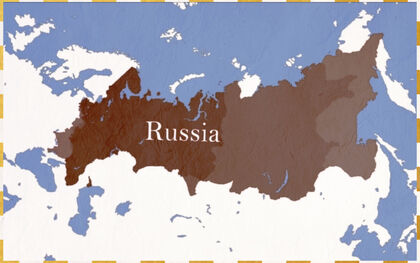
Russia gradually recovered from the "Time of Troubles" under the new Romanov dynasty’s first three Tzars, Michael (1613–45), Alexis (1645–76), and Fyodor III (1676–82). These three reigns, spanning seven-decades, were relatively stable, though still a difficult time. A peace treaty with Gustavus Adolphus of Sweden in 1617 left Russia in control of Novgorod, but excluded from Baltic trade. Meanwhile, the royal treasury was perpetually on the verge of bankruptcy. There were three significant developments of the early Romanov era. First, the powers of autocracy remained uncompromised. The Russian parliament (Zemsky Sobor) met fairly regularly, but was very ineffectual, and did nothing to limit the Tzar’s power. Second, the Romanovs won the allegiance of the Russian nobles (Boyars) by granting them still further privileges at the expense of the peasants and townsfolk. The new law code of 1649 confirmed serfdom as the condition of virtually all peasants, who accounted for 90 percent of the Tzar’s subjects. The oppressive conditions led to a series of peasant revolts, including the Salt Riot (1648), the Copper Riot (1662), and the Razin Rebellion (1667-72); the latter being by far the greatest peasant uprising in 17th-century Europe. And the third significant development was the rapid expansion of Russian territory. In 1648, a massive Cossack-led uprising in the Ukraine against Poland-Lithuania opened a an opportunity for Moscow to take over that region. Cossacks - the word comes from a Turkish word for robber or adventurer - were descendants of runaway serf, who obtained cavalry horse and took to a warlike freebooting lifestyle in self-governing communities. In 1654, Moscow reached an agreement with the Cossack leadership, which granted them military protection in return for allegiance to the Tzar; the ensuing war with Poland ended in 1667 with the division of Ukraine at the Dnieper River. The Cossacks then played a large part in Russia's drive to the east. The pattern involved Cossack bands pressing into a new region of Siberia, as yet occupied only by tribes. They established fortified settlements, and demanded tribute from the local population, as the Mongols once had. The tribute, now paid to Russia, was paid in the same currency, furs, which became a major part of Moscow's trade with the rest of Europe. The speed of advance across this open but inhospitable territory was astonishing. At the start of the Romanov era, in 1613, there were Russian outposts on the Yenisei River (1750 miles east of Moscow). The Lena River (another 1000 miles east) was reached in 1630, and the Pacific coast (750 miles further) in 1649. From the start, the Russian authorities found a secondary use for Siberia, as a place of enforced exile for dissenters in truly appalling conditions. One of the first victims of this very Russian punishment were the losers of a doctrinal crisis that split the Russian Orthodox Church. It occurred because the Patriarch Nikon (d. 1681), an enthusiastic reformer, corrected errors in liturgical and ritual practices that had been made over time in Eastern Orthodoxy; his chief opponent was banished to Siberia in 1653. Opponents to his reforms survived, becoming known as Old Believers, and remain a small but significant sect within the Orthodox tradition to this day.
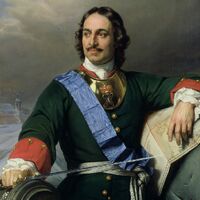
Peter the Great inherited a realm that was territoriality huge, but severely backwards. While the West was forging ahead with the Age of Discovery, Reformation, and Scientific Revolution, Russia remained isolated and insular. He led a political and cultural revolution that set institutional, social, and intellectual trends for the next two centuries. Seen in the light of his own aims, Peter’s autocratic reforms were effective. Yet he was and remains a controversial figure, admired for what he did and hated for how he did it, praised for modernizing his country and condemned for putting crushing burdens on his people, respected as a statesman and reviled as a tyrant.
At the death of Tsar Alexis in 1682, a struggle for power emerged between the families of his two wives - he remarried after his first wife died in 1669 - each of which offered a contender for the throne, feeble-minded Ivan and 10-year-old Peter; the future Peter the Great (1682-1725). The unsuitability of Ivan prompted the Russian parliament to proclaim Peter as Tsar, but Ivan's ambitious older sister, Princess Sophia, staged a bloody coup that established her as regent for her two brothers; Peter was eyewitnesses to the killing of several of his relatives. Sophia completely excluded Peter from public affairs, and he spent his youth at the summer palace in Preobrazhenskoe, just outside Moscow. This proved an important influence on the boy's life. Free from the stifling atmosphere at court, Peter grew to be highly intelligent, physically vigorous, strong-willed, and unusually tall, especially for the time period; an imposing 6 ft 8. He was fascinated by the nearby section of Moscow set aside for foreign residence, where he sought out European specialists teach him about western technology and warfare. His boyhood playmates were a motley crew from all stations in Russian society, far from what one would have expected for someone of royal rank. His closest friend, Aleksandr Menshikov, probably started his career as a street peddle, and eventually became one Russia's highest officials. He trained his friends into his own small private army, who were crucial for his survival during the events of 1689. That year, Peter turned seventeen, and pressure grew for Sophia to step down. Instead, she attempted to instigate another coup to remove her brothers, and rule in her own right. This time Peter's relatives prevailed, taking control of the government themselves and confining Sophia to a convent for the rest of her life. Peter was 22-years old when he began directly governing Russia in 1694, upon his mother's death. By then, he had acquired a wide range of military skills, and quickly put them to use. Peter was irked, like his predecessors, that Russia lacked a port on any sea, except Arkhangelsk on the White Sea, at once too out of the way and frozen for half the year. He selects the fortress of Azov on the Don as a suitable target. If he could take it from the Crimean Tatars, it would give him a warm water port on the Black Sea. As the Tatars were Muslim vassals of the Ottoman Turks, he would also be striking a blow for Christendom, as well as ending their raids into Russia. In the spring of 1695, Russian forces marched south and besiege Azov by land, but could not prevent resupply by river; they withdrew after two months. Peter's reaction to total failure was characteristic. He gathered some 26,000 craftsmen and labourers at Voronezh on the upper Don, and spent the winter building a fleet of ships; two warships, four fire-ships, twenty-three galleys and many smaller vessels. The Tzar himself supervised the work. In the next summer, the Russians took Azov. Peter was relieved but hardly satisfied. The campaign above all had revealed to him the extent of Russia’s military backwardness. Without naval specialists to build strong warships, his fleet would be bottled up in the Sea of Azov by the Ottomans; he had a warm water port but nowhere to go. Understanding full well that the most technologically advanced countries were in western Europe, Peter decided to send ambassadors there to enlist support against the Turks, though these efforts would run aground.on the rocks of the impending War of the Spanish Succession. The Grand Embassy was a remarkable 18-month tour of about 250 people. Characteristically, Peter decided he himself had to be among them. travelling "incognito" to escape social and diplomatic events. Above all, he was there to observe at first hand details of western technology and techniques. especially shipbuilding. He visited several European countries, but his most important destinations were the Dutch Netherlands and England, where he toured scientific institutes and shipyards. As one of the tallest men in Europe, Peter's ruse was an open secret from the start, and according to one observer, "the Tsar of Muscovy worked with his own hands as hard as any man in the yard". Significantly, he showed no interest in the Dutch or British parliament. Before returning home, he recruited about 750 engineers, architects, seafarers, and military specialists, mainly Dutchmen, to work and teach in Russia; it took 10 ships to ferry everyone home.
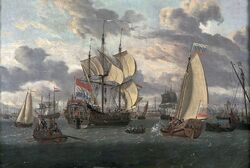
Peter onboard his yacht en route to the newly built frigate Peter and Paul.
In August 1698, Peter was back in Moscow, and more convinced than ever that Russia had to learn from Europe, if it was to become a modern, powerful nation able to hold its own on the international stage. He had had to hurry home, because the palace guard (Streltsy) had once again attempted to stage a coup aimed at restoring Sophia to power. The actual revolt had already been suppressed by the time Peter got home, but he took a personal interest in the interrogation, torture, and execution of those involved; more than a thousand corpse were put on public display as an unmistakable warning to others. Peter then set about implementing sweeping reforms aimed at modernizing Russia. It began with a dramatic gesture. Peter's obsession with the West had impressed upon him the notion that European customs were superior to Russian traditions. In the 17th-century, Russian men consciously preserved long beards over years. In what became a famous and symbolic scene, shortly after arriving in Moscow, the Tzar personally cuts a slice from the profuse whiskers of an assembly of leading noblemen. Henceforth, anyone at court was expected to be clean-shaven and adopt modern European dress, including “hats, jacket, and underwear”. He accompanies this assault with a practical measure containing a touch of wit; a new tax on breads. This was followed by an extensive programme of practical reform. Peter re-organized his government according to the latest Western political theory, moulding Russia into an absolute state. He replaced the old parliament (Zemsky Sobor) and council of nobles (Duma) with a small council of ministers (Senate), all appointed by the Tsar, who directed nine central departments with responsibilities for specific areas such as foreign affairs, state revenue, the army, the navy, and so on. Peter demanded that the nobles serve the state, either in the military or the government bureaucracy. To regularize the overall system, Peter established a Table of Ranks in 1722, a hierarchy of fourteen grades. Typical for Peter, members of the old nobility had to start at the bottom and work their way up on the basis of merit; commoners could also climb the ladder, and at a certain rank, attain noble status. The problem of corruption within the bureaucracy was tackled by encouraging a pernicious system of informers. Peter understood very well that a modern country needed an educated bourgeoisie. To that end, he issued a decree mandating education for all children of the nobility or state officials, and established Russia’s first secular schools and universities, run by foreign experts, specializing in technical, scientific, and practical subjects. Russians were also sent abroad to learn specialist skills in foreign academies; a Russian Academy of Sciences was set up shortly after Peter’s death, with his personal library at its core. As part of the government reform, the Orthodox Church was bought under tight governmental control. When the patriarch of Moscow died in 1700, Peter refused to name a replacement, instead establishing a synod of ten bishops, so that no one man could rival the Tsar’s power. Peter created the Russian navy from scratch and re-organised the army based on European methods - command structure, tactics, weaponry, and training - with the help of foreign experts. The manpower was provided by a national conscription that applied to all classes from peasants to noblemen, with the latter providing army’s officers trained in newly established military schools. Thousands of other peasants were were drafted to work in new mines, ironworks, powder mills, and other factories, both state-controlled and private enterprises, to produced the muskets, bayonets, artillery, uniforms, wagons, and anything else the army needed, all equal in quality to European equipment. The seven ironworks built in the Urals between 1701 and 1704 were the start of that region’s development into a centre of heavy industry, and the first major step in the industrialization of Russia. The Tzar never stopped improving his army. After a decade of effort. his standing army reached a strength of 200,000 men, second only to France in Europe. The navy numbered 28,000 men, four dozen major ships, and hundreds of smaller craft, that were good enough to worry Britain. Peter's measures touch all aspects of life. The currency was reformed, as was the Russian script; eight letters were lopped from an unwieldy Cyrillic alphabet. He undertook took the long-overdue step of reforming the Russian calendar, which at the time reckoned years from the presumed creation of the world. Unfortunately, at least for students of history, Peter adopted the Julian Calendar rather than the newer and more accurate Gregorian Calendar. That is why Russian history is littered with confusion over dates; the February Revolution (1917) that brought down the Tzar actually took place in March. Not until March 1918 did Russia finally adopt the Gregorian calendar. Although he was a far-sighted and effective leader, Peter was also known to be a cruel tyrant. The higher taxes and state monopolies that often accompanied his various reforms were bitterly resented by among poorer citizens, who bore the brunt of costs but saw none of the fruits of what we might call today Westernization. Before Peter, Russian peasants were taxed on a household basis. The flaw here from the state’s point of view was that peasants avoided the tax by squeezing as many bodies as possible into a single household. In 1718, the household tax was replaced by the poll tax on every adult male based on a careful census. State revenue soared, but its historical importance lies the social impact. It was the final major step in the solidification of Russian serfdom, reducing any peasants who for one reason or another were not serf to a similar status. Peasants conscripted into Russia’s new factories and mines, worked under terrible conditions and brutal punishments, even by the standards to which serfs were accustomed. These were bitter pills to swallow and peasant revolts were frequent throughout Peter's reign. He did not hesitate to savagely crush rebellions that questioned the state’s demands or methods. Peter meanwhile established a special bureau called the Preobrazhensky Prikaz to serve as a ruthless political police. He was not the founder of Russia’s secret police tradition - credit for that must go to Ivan the Terrible - but it took on ever more monstrous form under all succeeding Tzars.
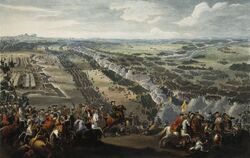
The Battle of Poltava was Peter’s greatest single triumph. It marked the beginning of Sweden's decline, while Russia took its place as the great power of north-eastern Europe.
As he initiated his reform, Peter simultaneously prepared his army for war. His plans for an anti-Ottoman alliance having failed, the new target was Sweden, master of the Baltic Sea. Peter was determined once again to secure warm-water ports for Russia. But he was not the only neighbour that sought to take advantage of the new Swedish king, Charles XII (1697-1718), who came to the throne at just 14-years-old. The Great Northern War (1700-21) was launched as an act of concerted aggression against Sweden by Russia, Poland-Lithuania, and Denmark; and was destined to last for more than two decades. At first, the war seemed to give conclusive proof that Sweden fully deserved her pre-eminence in the region, in large part due to the daring and military genius of the young Charles XII. Confronted by attacks on three fronts, Charles XII dealt with each in turn. First, he focused on the Danes, who were attacking Sweden's ally of Holstein. In August 1700, he outmaneuvered their naval blockade, bombarded Copenhagen, and forced Denmark out of the war. This allowed him to speedily redeployed his forces to the eastern Baltic coast, where Russian troops had laid siege to the port-city of Narva (now at the eastern extreme of Estonia). At the Battle of Narva (1700), a well-trained and equipped Swedish relief force routed a Russian army more than three times its size. Peter was fortunate that the mercurial Charles XII decided to focus his full attention on Poland instead of delivering a knockout blow against Russia. Over the next six years, the Swedish victories over Poland were devastating. In 1704, Charles XII coerced the Polish parliament to depose Augustus "the Strong" of Poland and Saxony, and replaced him with a Polish noble, Stanisław Leszczyński. Augustus resisted, but further victories forced him to sign the Peace of Altranstädt (1706), renouncing his claim to the Polish throne, recognising Leszczyński as king, and ended his alliance with Russia. Charles XII was now expected to win the war against the only remaining hostile power, Peter's Russia. However, Peter had used the lull to excellent effect, entirely retraining his army under mainly Prussian experts. While Charles was busying himself in Poland, Peter returned to the Baltic coast, and seized the mouth of the Neva River in 1703; he took Narva a year later. In the autumn of 1707, Charles XII moved east with an army of almost 44,000 men, with the intention of marching on Moscow the following summer, thus forcing Peter to withdraw from the Baltic to defend his capital. In a campaign that foreshadowed Napoleon Bonaparte's more famous offensive a century or so later, the plan was frustrated by Peter's use of scorched earth tactics. The Russian armies avoided battle and retreated continuously, dispersing the cattle, hiding the grain, and burning unharvested crops, thus leaving no resources for the Swedish army to stave-off the Russian winter. The winter of 1708-09 was famously one of the most severe in modern European history; frost fairs were held from the frozen Thames and lagoons of Venice. Charles XII's army shrunk to some 20,000 men, which moved south into the Ukraine, and, short of supplies, laid siege to the Russian fortress at Poltava, southeast of Kiev. A Russian force of 80,000 marched to relieve the siege. The ensuing Battle of Poltava (July 1709) was Peter's greatest single triumph and Charles's first disaster of his brilliant military career. With almost the entire Swedish army killed or captured, Charles himself fled south into Turkish territory. The Ottomans shared his hostility to the Russian and were eager to recover Azov, so joined the war. The resulting Russo-Ottoman War (1710–11) was the low point of Peter’s military career. The Russian army marched toward the Black Sea through the Balkans, expecting support from the Orthodox Christian population. But with minor and inadequate exceptions that help did not come, and the army found itself surrounded at the Pruth River by a vastly superior Turkish force. That misadventure cost Peter the return of Azov, and all the spoils from his earlier victory over the Turks; he considered himself lucky to have escaped so lightly. After three years of frustrating diplomacy with the Turks, Charles XII made his way back to Swedish territory in 1714, with the help of the Ausrian Habsburgs. In his absence, Sweden had once again been surrounded by enemies, with Denmark and Poland (Augustus the Strong had reclaimed the Polish throne in 1709) reentering the war, and Prussia and Hanover-Britain joining it. Russia occupied Finland where they committed great atrocities. Charles XII did manage to rebuild the Swedish army, and enjoyed some limited success until his death in 1718. Peace negotiations continue for another three years, and the final terms are a disaster for Sweden. Prussia gained Swedish possessions on the southern coast of the Baltic, including Pomerania. Hanover gained several Swedish possessions in Germany. And Denmark regained all its old commercial privileges on shipping between the Baltic and North Sea. But the greatest blow was Sweden's loss to Russia. By the Peace of Nystad (1721), Peter the Great returned the bulk of Finalnd, but annexed former Swedish territory along the Baltic coast; roughly from the modern Russian border with Finland to Latvia. With this, Sweden’s days as a great power were over; the first victim of a new one. A few weeks after signing the treaty, Peter formally took a new title, "Father of the fatherland, Peter the Great, Emperor of all Russia"; in effect marking the beginning of Russia’s imperial era.

Map of St. Petersburg in 1744.
Most great reform efforts have a showpiece; Peter’s was an entire city, appropriately named St. Petersburg. The Tzar wanted a new capital city that would promote his effort to modernize Russia; to be what he called Russia’s “window on the west”. The site he chose for his grand edifice, where the Neva River forms its delta before flowing into the Baltic Sea, came into Peter's possession in 1703. Within two weeks, he officially founded the new city he called his "paradise". This was not a promising place: a dreary marshy woodland, bitterly cold in winter, uncomfortably hot in summer. But Peter was not deterred in the least. Hundreds of thousands of serfs toiled under dreadful conditions that included several attacks by Swedish forces attempting to retake the territory; to the 30,000 workers who died Peter’s “paradise” was the “city built on bones”. Nor did the nobles Peter compelled to move from Moscow to St. Petersburg share his enthusiasm for the project. One member of the royal family expressed a widely held view when she wrote she hoped the city would “remain a desert”. In the end, as in so many other contests of will, Peter triumphed. During his reign the Tzar brought outstanding craftsmen from Europe to create elegant and graceful stone buildings. No detail escaped his attention. He beautified his city with 5,000 trees imported from Holland. The city grew, officially becoming Russia’s capital in 1712, and by the end of Peter’s reign had a population of 100,000. After Catherine the Great had made her contributions, St. Petersburg was one of Europe's great capitals. Almost by sheer force of will, Peter linked Russia permanently with to Europe, and the Russian Empire would henceforth loom large in European affairs. For all his vision for Russia's future, Peter did a poor job of preparing for his succession. Peter's mother selected his first wife, who bore him a son, Alexie, but the marriage was an unhappy one; he divorced her in 1698 by forcing her into a convent. His second wife, who he married in 1712, was his former mistress, a beautiful Polish-Lithuanian peasant who was received into the Russian Orthodox church under a new name, Catherine. Unfortunately for Peter, Catherine only bore him daughters. His son, Alexie, was a conservative and scholarly young man, who had been brought up by his mother to disdain his father. Tension between them finally provoked Alexis to write a pitiful letter to his father in 1716, offering to renounce the throne in favour of his own infant son. Peter agreed but only if Alexei entered a monastery to remove himself as a dynastic threat. Instead, he fled from Russia, taking refuge with the Austrian emperor. Peter, viewing this as treason, tricked the young man into returning home on a promise of clemency. He then imprisoned him, and tried to torture his friends into confessing to a conspiracy. Little evidence emerged, so Alexie died discreetly in the St. Petersburg's fortress, after twice being flogged within inches of his life with the fearsome Russian whip known as the knout. Peter died in early 1725, and was succeeded by his second wife as Empress Catherine I (1725-27), as regent for his nine-year-old grandson. In doing so, she blazed a trail for an unusual series of female rulers of Russia. Five rulers sat on the throne between the country’s two “Great”, Peter the Great and Catherine the Great; three were women.
Rise of Prussia[]
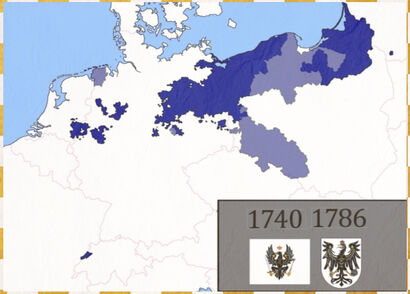
After the Thirty Years' War, the states of the Holy Roman Empire, granted their independence by the Peace of Westphalia, were a numerous and very mixed bunch. About 200 were ruled by princes (dukes or counts), and another fifty by high clergymen (archbishops, bishops or abbots). Then there were the free cities, many not much more than market towns. Among the princes, there were five great dynastic families whose rule covered huge areas. By far the most powerful were the Austrian Habsburgs, with their hereditary lands occupying the south-east of the empire. To the north of them were the Wittelsbachs, the prince-elector of most of southern Germany, including Bavaria and the Rhineland Palatinate. In north-western Germany, the ancient House of Welf had many provinces, of which Brunswick and Hanover were the most important. The north of Germany was in the hands of the Wettin, a family headed by the prince-elector of Saxony. And beyond Saxony, in the north-east, was the territory of the newcomer, the Hohenzollerns, who had only been since 1415 prince-elector of Brandenburg. A lessor branch of the family also held Prussia since 1525, a duchy on the Baltic that had establish by the Teutonic Knights in the 13th-century; this Hohenzollern line dies out in 1618 and passed to Brandenburg. These two states were separated from one another by part of Poland, including the valuable port of Gdansk. Brandenburg itself was poor, having lost half its population in the Thirty Years War; the capital, Berlin, had only 6,000 inhabitants. Sweden was the dominant power in the Baltic, who regarded Prussia as a minor, if useful, potential ally in their own wars against Sweden and Russia; Prussia was notionally still a vassal the Polish crown. The profusion of principalities in the 18th century was of considerable benefit to German culture, with princes competing with one another in the quality of the entertainment they could offer. Georg Frideric Handel and Johann Sebastian Bach were born in the same year of 1685, and together were the towering figures of baroque music. Johann Wolfgang Goethe is regarded as Germany's greatest literary figure, best known for The Sorrows of Young Werther; it was the young Napoleon’s favourite book and in Frankenstein, the monster learns about humanity by reading it.

Frederick William I, popularly known as "the Great Elector", who set Brandenburg-Prussia on a distinctive path toward an absolutist and militaristic nation-state. that endured until 1918.
During the 17th-century, Brandenburg-Prussia began to establish a position second only to the Habsburgs. Toward the end of the Thirty Years' War, it passed to the very talented Frederick William Hohenzollern (1640–88). Following the Peace of Westphalia, the "Great Elector", as he became known, successfully rebuilt his war-ravaged territories through astute political, military, economic, and diplomatic leadership that propelled him into the ranks of prominent absolutism rulers. By cleverly playing the Poles, Swedes, and Russians off one another during the Second Northern War (1655–60), he managed to get himself declared the fully sovereign duke of Prussia in 1657. He forced the high nobility of his various territories to grant him permanent taxation rights, thus stripping the parliaments of their main source of power; in return, the nobles were promised free-rein with their peasants and exemption from most taxes. He then used the money to build and sustain a standing army of 40,000 troops (soon 80,000) from a population of no more than 3.5 million; an army so disproportionately large that the French philosopher, Voltaire, famously quipped, "other states have armies; in Prussia, the army has a state". Soldiers also asserted juridical, tax-collection and policing powers, so that any opposition to his measures was easily crushed. The root of Prussia’s military might lay in the deal Frederick William made with the Junkers, the lessor nobility. The term originally meant younger sons of a German lord, the sort of men who were ready to stake their lives on armed expansion with the Teutonic Knights. The Junkers were by now far poorer than most western aristocrats, because, in a practice unique to east of the Elbe, their estates could not be sold by law to non-Junkers; originally designed to prevent Slavs buying land. But this meant estates could not be mortgaged to make improvements. The net result was an enormous number of proud young men, bred to arms, with absolutely no money. In a bargain unique to Prussia, Frederick ensured that only noblemen of proper lineage became officers in his army. And they made wonderful officers, walking into cannon-fire, and driving their men into it too. The opportunity to test his new army came in the Scanian War (1675-79), an offshoot of the Franco-Dutch War. Louis XIV bribed Charles XI of Sweden (d. 1721) to remain neutral in the war, and prevent Brandenburg-Prussia from helping the Dutch. The war began when Frederick William joined an anti-French alliance, and Sweden promptly upheld their part of the bargain. When the hitherto invincible Swedes invaded, the Prussian army astonished all Europe by defeating them at the small but spectacular Battle of Fehrbellin (June 1675) near Berlin. Meanwhile, to pay for his army, Frederick taxed heavily, while supporting measures that would increase the tax base, such as building up industries, paying attention to infrastructure especially canals, and welcoming skilled French Huguenots following Louis' revocation of the Edict of Nantes. Together with a tightly controlled and lean bureaucracy, Frederick William bequeath to his son a thriving economy, Europe's best-trained army, and powerful realm; as dukes of Prussia, a sovereign nation outside the Holy Roman Empire, and as dukes of Brandenburg, a prestigious prince-elector within it.

The coronation of Frederick I as King in Prussia at Königsberg in 1701. The royal title means that from this point onwards the emphasis in Brandenburg-Prussia was on "Prussia".
These achievements enabled, Frederick III Hohenzollern (1688-1713), to achieve the next crucial step. In 1700, Emperor Leopold I Habsburg was in need of allies against France in the War of Spanish Succession. Frederick's price was the status elevation of Prussia from a duchy to a kingdom. Within the Holy Roman Empire, no one could call himself king except the emperor as king of Bohemia. There thus couldn't be a king of Brandenburg, but, using the legal nicety that Prussia was outside the empire, Frederick was allowed to call himself the "king in Prussia". The title "king of Prussia" could not be used because it might offend the Polish king whose kingdom included a province called Royal Prussia, though such niceties were dispensed with after the Partition of Poland in 1772. The royal title was not merely decorative, but regarded as a political necessity in the competition between German prince-electors; George I Hanover had recently secured the English throne, while Augustus "the Strong" of Saxony had secured the elective Polish throne. Frederick's son, Frederick William I Hohenzollern (1713–40), took devotion to the army to new heights. The "Soldier King", as he became known, led an austere Calvinist lifestyle, always wore military uniform, undertook reform of training, tactics, and conscription, and personally drilled the army relentlessly; soldiers were expected to fire six times a minute, three times faster that most armies of that period. His army became the envy and terror of Europe, so much so that he actually needed to use it relatively rarely; his troops only briefly saw action in the Great Northern War. Frederick also did much to improve Prussia's economy and bureaucracy. He exempted the merchant class from military service, supported compulsory primary education, and rewarded royal officials on merit even if they were commoners; on the other hand, minor infringement were severely punished, and two infringement meant instant dismissal. He expected martial values to shape all of Prussian society, not just the army, with discipline, obedience and order the most prized virtues.
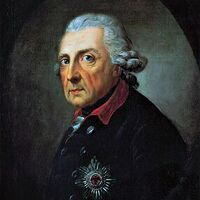
Frederick the Great, a brilliant military campaigner who greatly enlarged Prussian territory, largely at the expense of the Habsburgs and Poland, and made Prussia perhaps the foremost military power in Europe.
When Frederick II Hohenzollern (1740-86), better known as Frederick the Great, inherited the throne of Prussia, at the age of twenty-eight, he was an exceptionally cultured young man. In his youth, he had been mostly interested in music, books, and French culture. He conducted a regular correspondence with French philosopher, Voltaire. After studying the works of Niccolò Machiavelli, required reading for any young prince in Europe, he anonymously published a political refutation based on enlightened principles. His severe father, whose only interests were administration and the army, was alarmed by his son's artistic tendencies, and did his best to force the boy into a life of military discipline; frequently beating or humiliating him. At the age of eighteen, Frederick plotted with a friend to escape from his father for a visit to England. The scheme was discovered, and the pair were treated as a deserter. Frederick was court martialed and then imprisoned, where he was compelled to watch his friend's execution. It is not surprising that Frederick emerged in adulthood as a formidable personality; he must have had reserves of strength to survive such a childhood. When he inherited the crown, in 1740, it is clear that he still retained his intellectual and artistic interests. In the first year of his reign, Frederick established a court orchestra under C.P.E. Bach; the son of Johann Sebastian Bach. Two years later, he provided Berlin with an opera house. But he also did something which his father would have admired. He reacted with startling vigour to the death in October 1740 of the the Austrian Emperor, Charles VI Habsburg, with no male heirs. Charles issued an imperial decree, the Pragmatic Sanction (1713), allowing his eldest daughter, Maria Theresa, to inherit. Frederick was one of the first to exploit Austrian weakness, thereby beginning the War of Austrian Succession (1740-48). In early December, he delivered an ultimatum to Maria Teresa, to cede the Habsburg possession of Silesia to Prussia, in return for confirming the Pragmatic Sanction; a territory that had been vaguely disputed since the extinction of its ruling dynasty in the 16th-century. Frederick's demand was refused almost immediately, and, two weeks later, he stunned Europe by marching a Prussian army into the rich province. Maria Theresa was also a woman of strong resolve, but Austrian armies prove no match for the Prussians. The Battle of Mollwitz (April 1741) was Frederick's first battle, in which neither army acquitted itself well. When the Austrian cavalry scattered the Prussian right-flanks, Frederick himself abandoned the field to avoid capture, leaving his lieutenant to lead the disciplined Prussian infantry to victory. Victory at Mollwitz emboldened the French and Bavarians to attack the beleaguered archduchy. Their intervention was of great help to the Prussian adventurer, but Frederick shows no interest in becoming involved in a wider conflict. He continued to occupy Silesia, and fought battles only its defence, culminating in a decisive Prussian victory at the Battles of Hohenfriedberg (June 1745). This was one of Frederick's most admired victories, studied by later officers as a model for aggressiveness: deploying in the dark to conceal his movement; advancing in orderly lines as if on a parade ground; granting officers a large amount of autonomy to exploit opportunities; the spirit of aggression instilled in the entire army; and the unexpected cavalry charge in the centre that finally broke the exhausted enemy line. For the next few years, Maria Theresa half-heartedly remained in a war whose nature had changed; becoming primarily a conflict between France and Britain. Frederick had enough time of his hands to build the Sanssouci in Berlin, a Rococo-style summer palace where he could relax away from the pomp and ceremony of the Berlin court. Both monarchs awaited the eventual settlement, which came in the Peace of Aix-la-Chapelle (1748). Apart from adjustments between Austrian and Spanish holdings in Italy, the peace restored to their previous owners the territories occupied during the eight years of the War of the Austrian Succession; with one exception. Frederick, whose sudden aggression launched the conflict, was formally recognised as sovereign over Silesia. This added one of the most densely industrialized German regions to Prussia, nearly doubling its population and increasing its territory by a third. This was only the first round of the long struggle for leadership in Germany between Austria and Prussia. that would not be settled until the 1860s.
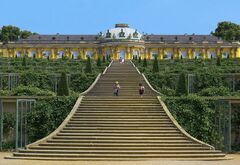
Like many European rulers of the time, Frederick adopted French tastes and manners. Even his private residence just outside Berlin got a French name, Sanssouci ("carefree"). He left instructions that he should be buried on the vineyard terrace, but his successor instead had him entombed next to his father. In 1991, Frederick's body was finally laid to rest at Sanssouci, in accordance with his will.
Frederick the Great's wars had only just begun. Maria Theresa of Austria remained his most unforgiving opponent; calling him "that evil man in Sanssouci". Austria almost recovered Silesia, when it managed to put together a grand coalition with France and Russia in the Seven Years War (1756-63). Prussia only survived because Britain, engaged in global war with France, pumped enormous subsidies into Berlin, and because Elizabeth of Russia died - who loathed Frederick - and was succeeded by Peter III - who adored him. In 1772, Frederick physically connected most of his realm by seizong large portions of Polish territory in the First Partition of Poland. And late in life, he involved Prussia in the low-scale War of the Bavarian Succession (1778-79), to thwart Maria Theresa's attempt to exchange Austrian Belgium for Bavaria. Frederick used the years between the wars to modernize Prussia. He viewed kingship as a duty; it was his obligations to protect his subjects, to make them prosperous, and to give them honest administration. He reformed the judicial system, prohibiting the death penalty without a warrant signed by the king himself, abolishing most uses of judicial torture, moving the law towards greater equality, and making it possible for non-noble to become judges and senior bureaucrats. He also re-codifyied the law code, one of the most important 18th-century efforts of its kind. With the help of French experts, he improved the tax system by introducing indirect taxation, which provided the state with more revenue than direct taxation. He presided over the construction of canals to promote internal trade, protected his industries with high tariffs, and created new farmland through draining swamps and founding new villages. A government reserves of grain were built up, to control bread prices in years of famine or poor harvests. The thing the marked-out Frederick in the eyes of contemporaries as a Enlightened ruler, was his pursuit of religious tolerance. This was largely pragmatic: to integrate Catholic Silesia and western Poland into Prussia; to promote trade with Poland where most merchants were Jews; and to attract a diversity of skills to his realm, whether from Jesuit teachers, Huguenot merchants, or Jewish bankers. Frederick also supported arts and science. He allowed freedom of speech in press and literature, and was one of the first rulers to attempt to introduce universal primary education; Prussia's education system was already regarded as one the best in Europe. As well as an opera house, Berlin was provided with a royal library, a rejuvenated Academy of Sciences, and St. Hedwig's Cathedral.
Frederick's long reign, his military successes, his ceaseless devotion to furthering Prussian interests, and his renown as the ruler that Voltaire called the "philosopher king" all combine to make him the pre-eminent example of an "enlightened despot" so admired in 18th-century political theory. He died childless - he was almost certainly homosexual - and was succeeded by his nephew and great nephew, Frederick William II and Frederick William II, who proved less capable. Frederick William II failed to deal adequately with the challenges to the existing order posed by the French Revolution. Frederick William III ruled Prussia during the severe challenge of the Napoleonic Wars, suffering a humiliating military defeat in 1806.
War of Spanish Succession[]
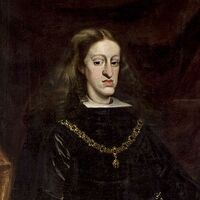
Portrait Charles II by Juan Carreño de Miranda, 1685
From the 1690s, all of Europe was obsessed with the death, thought imminent, of king Charles II Habsburg of Spain (1665-1700). The Spanish monarchy had created a problem for their royal line by intermarrying within the House of Habsburg. Charles II, the only surviving son of Philip IV, suffered severe mental and physical infirmity, and was in all likelihood sterile. With no heir, the question of the day was who would inherit the vast Spanish domains, including Spanish Belgium, possessions in Italy, the Americas, and the Philippines. Two of the most powerful monarchs in Europe could make almost identical claims for their children; Louis XIV Bourbon of France and Leopold I Habsburg of Austria. Both men had a Spanish Habsburg princess as a mother and a Spanish Habsburg princess as a wife. Despite being at loggerheads in the recent Franco-Dutch War and War of the Grand Alliance, Louis XIV and William III of Britain joined forces to try and resolve the issue by diplomacy; both were anxious to avoid another costly war, but determined to prevent the reassembling of the great Habsburg domain held by Charles V Habsburg in the 16th century. They signed a partition treaty whereby a compromise candidate, 6-year-old Joseph Ferdinand of Bavaria, would inherit the Spanish crown, with Spain's possessions in Italy shared between the Austrian Habsburgs and French Bourbons as a compensation. Alas the boy died in 1699. Undaunted, Louis and William came up with a second partition treaty, the Treaty of London (1700), whereby Leopold's younger son was to have almost all the Spanish domains except those in Italy, seemingly a rather generous offer but without the linchpin of Milan the two Habsburg dominions would find it difficult to function together. Shortly before his death in 1700, Charles II finally made his choice, and changed his will to leave the throne to the Bourbon claimant; Philip, the younger grandson of Louis XIV. Perhaps he was convinced only France had the power to keep the Spanish possessions intact, or perhaps it was simply a fit of pique at the high handed wrangling over his heir.
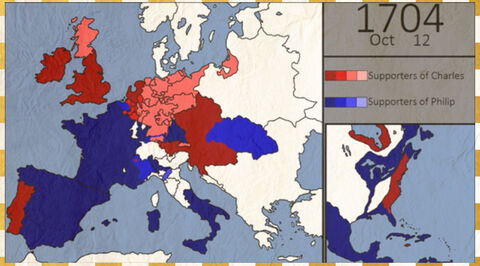
Historians have long debated about whether the War of Spanish Succession (1702-14) was now inevitable. It is difficult to see how Louis XIV could have done anything but accept the late king's bequest to his grandson, Philip V Bourbon of Spain (1724-46). The alternative meant handing the Spanish throne to Habsburg Austria, whose domains would surround France on all sides. Leopold of Austria had rejected the Treaty of London, and there was little change the British and Dutch would fight to enforce the partition. Perhaps if Louis had acted more diplomatically, the conflict might have be contained to France and Austria. But a series of provocations - moving French troops into the Spanish Belgium alarming the Dutch, and granting French merchants trading advantages in the Spanish Americas antagonized both Dutch and British interests - turned a delicate situation into one in which France was again faced by a hostile alliance of major powers. The Grand Alliance was rapidly re-mobilised, eventually including Austria, Britain, the Dutch Netherlands, Prussia, Portugal, and Savoy (centred on Turin north-western Italy). France and Spain could meanwhile only count on Bavaria as a reliable ally.
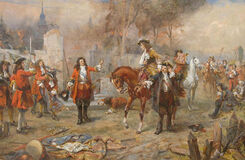
The Duke of Marlborough greeting Prince Eugene of Savoy after their victory at the Battle of Blenheim.
Although the detailed development of the war is very complicated, the basic aim of each side was clear; to trying to control of certain territories that made up Spain's European empire. The Grand Alliance was blessed with the two most brilliant generals of the war; Prince Eugene of Savoy and the English Duke of Marlborough. Each made early inroads. Prince Eugene rapidly seized much of Spanish northern Italy, while Marlborough swept the French from the Spanish Belgium. But a bold French initiative in 1704 threatened to make these peripheral successes of trifling importance. A joint French and Bavarian army pressed eastwards to threaten Vienna itself, hoping to take Austria out of the war, which was struggling to suppress a Hungarian war of independence. However, a rapid 250-mile march by Marlborough from the Low Countries brought him to the Danube in time to join Prince Eugene. The resulting Battle of Blenheim (August 1704) was the outstanding victory of the war for the Grand Alliance; instead of Austria, Bavaria was knocked out of the war. In that year, the Grand Alliance had considerable success at sea too. Gibraltar was taken by a British and Dutch expedition, and an English fleet defeated the French at the Battle of Málaga (August 1704), the largest navel engagement of the war. These two events gave the allies command of the Mediterranean for the rest of the war. Allied efforts to exploit their victories in 1705 foundered on poor co-ordination. The stalemate was broken in 1706 with the Grand Alliance achieving spectacular successes. Prince Eugene's brilliant campaign that summer in north Italy was so convincing that Louis XIV withdrew all his troops from that theatre of the war. At the same time, an Allied force under Marlborough shattered the French at the Battle of Ramillies (May 1706), and Louis was swept from the Low Countries too. The setbacks of 1706 prompted Louis XIV, old now and perhaps weary, to discuss a possible peace. His very reasonable offer of returning to the Treaty of London (1700) was rejected; the allies were now determined that the Bourbons should benefit from no part of the Spanish inheritance.

The Battle of Malplaquet, an Allied victory with no strategic gain. The losses shocked Europe and increased the desire for peace.
The war continued, and because of the close links between war and trade, extended beyond Europe, particularly to North America, where it is known as Queen Anne's War (1702-13), and perhaps more noteworthy for justifying massacres of native American Indians. It also spread to the West Indies, India and Asia, where it particularly strained Dutch naval resources. The situation in Europe stabilised for the French, when Marlborough and Eugene launched an invasion, advancing on Paris, and defeating the French at the Battle of Malplaquet (September 1709), the bloodiest battle of the war. Despite winning, the allies lost over 20,000 men, twice as many as their opponents. Unable to proceed with the invasion, the defeat ended Austrian and Dutch hopes of a breakthrough in Northern France. A subsequent allied invasion of Spain in 1710 also failed to make any progress, because the population remained fiercely loyal to Philip V. The Grand Alliance, in the meantime, was cracking. In 1710 in Britain, the Whigs suffered an election defeat to the Tories who were inclined towards peace. Moreover, the friendship between Queen Anne and Marlborough's wife came to an end, and with it much of his political clout. Then in 1711, the eldest son of Leopold of Austria unexpectedly died, bringing his brother Charles VI Habsburg (1711-40) to the imperial throne. This undermined the cause of the Grand Alliance; their aim had been to place Charles on the throne of Spain, but nobody wanted him to inherit it as well as being Austrian emperor.
The War of Spanish Succession was brought to a close with two separate peace treaties; the Treaty of Utrecht (1713) and Rastatt (1714). The House of Bourbon could be said to have gained the greatest advantage in the war. Philip V Bourbon was recognised as king of Spain and its overseas empire, but renounced his place in the French line of succession, for himself and his descendants. This precluded the union of the French and Spanish crowns, though they remained close allies. But other nations made significant gains too, particularly the British. They won strategic bases in the Mediterranean at Gibraltar and Minorca, and territories in North America disputed with the French in Newfoundland, Nova Scotia and the Hudson Bay, as well as commercial privileges in the Spanish Americas. Louis XIV also recognised the Protestant succession, and promised to give no further support to the exiled Jacobites; the same pledge had been made before the war, but broken during the conflict. The Austrian Habsburgs were granted Spanish Belgium as compensation, and to provided a buffer for the Dutch against further French aggression. The Habsburgs also profited in Italy, though the dust took longer to settle there. A still disunited Italy underwent another thirty-odd years of uncertainty, as minor representatives of European royal houses shuffling around it attempting to tie up the loose; Spain for instance reclaimed Sicily and Naples in 1734.
Longer term, the settlement represented a major adjustment to the European balance of power, that held good until the French Revolution 75-years later. For the first time the treaty of 1714 declared the aim of the signatories to be the security of peace through a balance of power. So practical an aim was an important innovation in political thinking. There were good grounds for such realism; the war left the participants with unprecedented levels of debt. Wars were more expensive than ever, with the average size of armies having almost trebled in the 60 years since 1648; a level unsustainable for pre-industrial economies. All the great powers saw peace and trade as in their national interest, and Europe enjoyed 25-years of relative peace until the War of Austrian Succession. It also marked the rise of Britain as the leading European maritime and commercial power, at the expense of both France and Spain; she recovered financially from the war in years, while France took decades. Another state on the rise was Prussia, which would henceforth be the great rival of the Austrian Habsburg for supremacy within imperial Germany. In contrast, the Dutch Republic ended the war effectively bankrupt, permanently affecting their commercial and political strength. Finally Spain, the cause of the conflict, became a second-rate power after being stripped of its territories in Italy and Belgium.
War of Austrian Succession in Germany[]

The Thirty Years War had left imperial Germany depopulated and impoverished, and made it clear that the Empire would not be transformed into a strong state united in religion. It also left Habsburg Austria clearer to concentrate on their own complex group of territories: German-speaking Austria itself and several smaller territories; Czech-speaking Bohemia; and Hungarian-speaking Hungary. Greater centralisation and administrative uniformity were essential if the Austrian Empire was to exercise its due weight in European affairs. In Bohemia, the native nobility, most of whom were Protestant, had been defeated militarily in the Thirty Years War, and the victorious Habsburgs gave their lands to the few loyal Catholic nobles. This new nobility helped them wipe out Protestantism, bring in Jesuits to open schools, centralize their rule, and impose harsher controls on the population; this last left the native Czechs virtually limited to peasants working for German-speaking landowners. The Habsburgs carried out similar measures in Austria. and then turned to Hungary. Hungary had been divided between the Ottomans and the Habsburgs after the Battle of Mohacs (1526), but before then it had been an independent state for several centuries. Throughout the period of foreign rule, it maintained a strong sense of national identity largely centred on its distinctive language; among the few non-Indo-European languages spoken in Europe. Many Hungarians living under the relatively tolerant Ottomans became Calvinist, or even more radical religious groups. In the Peace of Karlowitz (1699), the Habsburgs recovered the whole of Hungary, and then attempted to impose the blend of absolute rule and Catholic religious intolerance which had been applied to Bohemia. Hungary proved more resilient, however. The removal of Austrian troops in 1703, needed elsewhere in the War of Spanish Succession, was followed by a series of uprisings; Rákóczi's War of Independence (1703-11), The rebellions were defeated by 1711, but the Habsburgs were forced to accept that Hungary would not be merged with the rest of the Austrian empire; it continued to be ruled through its own representative assembly (Diet), according to its own laws and traditions, until the end of the Austrian Empire in 1918. Except for that, the War of the Spanish Succession was a great boon for the Austrian Habsburgs, who gained Spanish Belgium, along with Spanish holdings in Italy, though the latter proved to be temporary.

Maria Theresa Habsburg, the only female ruler of the Austrian Empire.
The Austrian Habsburgs had their own succession problems, however. Emperor Charles VI Habsburg (1711-40) had no sons; only two surviving daughters. However, imperial law officially excluded women from the inheritance; based on the Salic Law, which also excluded women from the throne of France. Charles issued an imperial decree, the Pragmatic Sanction (1713), allowing his eldest daughter, Maria Theresa (d. 1780), to inherit. Ensuring her succession dominated the rest of his reign, He got every German states of any significance, as well as most European countries to agree. At his death, however, Austria was perceived as weak, and several of these reneged on their promises, resulting in the War of the Austrian Succession (1740–1748). Dynamic and ambitious young Frederick the Great of Prussia was just the first to take advantage, seizing Silesia, Austria's most economically developed region. From the summer of 1741, Maria Theresa had the French and Bavarian to cope with, as well as the Prussians. Bavaria, whose ruler was married to her younger sister, challenged her title as Holy Roman Emperor, and claimed a share of the Habsburg inheritance. It suited the French to support Bavaria, always eager to diminish Habsburg power, which encouraged Saxony to follow suit, and Spain to try to oust the Habsburgs from Milan. By November, French and Bavarian armies had push through upper Austria into Bohemia, and entered Prague. Maria Theresa had to flee Vienna, and was advised on all sides to come to terms. In defiance of the grave situation, she managed to secure the vital support of the Hungarians for the war effort, as well as the British, out of hostility toward France rather than any loyalty to the Pragmatic Sanction. Contrary to all expectations, the young empress drove the French and Bavarian forces back so successfully that by January 1742 the Austrians were in the Bavarian capital of Munich; though Prague was not recovered till December. By 1744, the focus of hostilities had shifted away from central Europe, to a direct conflict between Britain and France. In 1745, Britain, eager that Austrian armies should concentrate on France, persuaded Maria Theresa to come to terms with her real enemy, Frederick the Great. The war dragged on for another three years, with fighting in northern Italy, Austrian Belgium, and at sea where the British did serious damage to French trade. The Peace of Aix-la-Chapelle (1748) made a few minor adjustments between Austria and Spain in the patchwork of Italy, but otherwise, with one exception, restored to their previous owners the territories occupied during the war; Austria returned Bavaria and French returned Austrian Belgium. Maria Theresa was forced to give up the province of Silesia to a new power on the scene, Prussia, but was recognized as the legitimate ruler of Austria, Bohemia, and Hungary; her husband, Francis I of Lorraine, became the Holy Roman Emperor. For Maria Theresa, the loss of Silesia rankled, which played a role in the subsequent Seven Yeas War (1756-73).
Maria Theresa of Austria[]
Maria Theresa was herself deeply conservative and by no means sympathetic to Enlightenment ideas, but, after the 1740s, it became clear that the Habsburg monarchy was in a struggle for supremacy with Prussia. She further strengthened the centralized bureaucracy, reformed the tax system so that even nobles had to pay some taxes, and limited the independent power of the papacy in Austria. With the assistance of Friedrich Wilhelm von Haugwitz, she reorganised Austria's ramshackle military, creating a modern standing army of 108,000 men. When Haugwitz was then appointed head of the bureaucracy, he initiated a radical centralization of state institutions. She also promoted commerce, strengthening Austria's industry and agriculture through government intervention, and erecting trade barriers to encourage Silesia's textile industry to move to Bohemia. Between 1754 and '64, Maria Theresa doubled the state revenue, though her attempts to tax the Church and nobility was only partially successful. Although her education reforms had merit - establishing secular primary schools, a curriculum that emphasised reason over rote-learning, and universal education until the age of 12 - they met with resistance particularly from peasants who wanted the children in the fields instead; in many parts of Austria, half of the population was illiterate well into the 19th-century. Historians have generally considered Maria Theresa's 40-year reign to be very successful when compared to other Habsburg rulers, though she's rarely included among the Enlightened monarchs, due to her support for censorship and judicial torture, and especially her religious intolerance. Once the road to reform had been entered upon, it was bound in the end to lead to conflict with the Church and various provincial nobilities. This came to a climax during the reign of Maria Theresa’s son and successor, Joseph II Habsburg (1780-90), who introduced even more sweeping reforms; abolishing serfdom, improving legal procedures, decreeing religious toleration, and attempting to control the Church. However, Joseph had antagonized the nobles of Brabant, Hungary and Bohemia to the point of open defiance, and powerful local institutions virtually paralysed the government by the end of his reign.
Parliamentary Monarchy in England[]

The flag of Great Britain following the Act of Union (1707) between England and Scotland, consisting of the red cross of Saint George, superimposed on the Saltire of Saint Andrew. Saint Patrick's Flag was added with the Act of Union (1801), creating of the United Kingdom of Great Britain and Ireland.
After more than half a century of conflict with the Stuarts, with the reign of William III and Mary II (1689-1702), it was clear that things really had changed. England was now in effect ruled by a wealthy Protestant oligarchy through parliament. The monarch still had a role, but by no means a commanding one. William III had come to England to further his continental ambitions, but even when parliament granted permission to participate in the War of the Grand Alliance (1688–97). the expenditure was carefully overseen. Even the question of succession was settled by parliament with the Act of Settlement (1701). It established the principle that only Protestant members of the royal family could wear the crown. Mary II died of smallpox in 1694, leaving William III to rule alone. The marriage had not yielded any children, and the crowned passed on William's own death in 1702 to Mary’s sister Anne Stuart (1702-14). The most significant even of Anne's reign was the Act of Union (1707), a political union between England and Scotland. Although the Stuart Dynasty had originated in Scotland, the northern kingdom had largely been ignored since the personal union of the crowns since 1603. The late-17th-century was difficult for Scotland. In an era of economic rivalry in Europe, Scotland was incapable of protecting itself from English competition, while denied tariff free trading access to England or its developing colonies. In 1695 some of Scotland's merchants founded the Company of Scotland, a colonial enterprise similar to the English East India Company, with the aim of establishing a port on the Gulf of Darién (modern-day Panama), and thus becoming the middleman in all the trade of the new world. The scheme was a runaway success, with Scotland's nobles, merchants, cities and boroughs investing; by some estimates 20% of all the money in Scotland ended up in the Company. But the colony never stood a chance; the English passively opposed it, keen to maintain a monopoly on foreign trade, while the Spanish opposed it militarily. The Company of Scotland collapsed within five years. Self-interested Scottish politicians engineered the Act of Union in order to recover their personal financial losses. It abolished the Scottish parliament, giving the Scots instead a proportion of the seats in Westminster. There were safeguards for Scotland's legal system, radically different from English common law. For the Scottish elites, the union was hugely unpopular; ignored as the Scottish parliament, they could now play an active role in the heart of the politics. For the rest of Scotland, the loss of centuries of independent sovereignty was harder to swallow, not least because it brought higher English taxes.
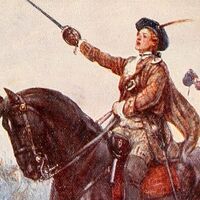
Bonnie Prince Charlie
The faction that had remained loyal to James II, and now to his son James the Old Pretender (d. 1766), was revived by the unpopularity of the union. In 1708, the Old Pretender attempted to invade Scotland with a French fleet, but storms and the English navy prevented the landing. A more serious attempt was made soon after Queen Anne's death in 1714. Despite seventeen miscarriages, she died without an heir and was the last monarch of the House of Stuart. Under the Act of Settlement (1701), which excluded all Catholics, Anne was succeeded by her German Protestant cousin, George I Hanover (1714-27). The Jacobite Rising of 1715 envisaged simultaneous uprisings in Wales, Devon, and Scotland. However, the ventures south of the border were mostly betrayed and suppressed before they got started. In Scotland, 10,000 men rallied to the Jacobite cause under the earl of Mar, particularly from the Highlands, tempting the Old Pretender to cross from France bringing money. But Mar proved an incompetent general, and was defeated by a government force almost half his size near Stirling, before the Old Pretender landed in December. Finding his support disorganised and plagued by desertions, he decided that discretion was the better part of valour and was back in France two months later. The fiasco of this uprising, known simply as the Fifteen, ensured that the Hanoverians are secure on the British throne. But the Jacobite cause remained a romantic one, passionately held, and surfaced again thirty years later in a final and more serious rising, the Forty-Five, led by the grandson of James II, known as Bonnie Prince Charlie or the Young Pretender. He landed in the Hebrides early in August 1745 with just seven companions. Less than half the Highland clans rallied to his cause, but he gathered a force large enough to march on Edinburgh. Yet support for the government was no more enthusiastic, and most Scots simply let them pass. In September, Charles entered the Edinburgh and then defeated the only government army in Scotland at the Battle of Prestonpans. Many of his followers now advised that he should simply take Scotland, but Charles was convinced that victory awaited him, and marched south to invade England. The Jacobite army took Carlisle and advanced as far as south as Derby. However, it became increasingly evident that England would not support a Catholic Stuart, and his followers lost heart; they were too far from the safety of Scotland, and promised French support had failed to materialise. In December, Charles reluctantly headed back north, pursued by an English army recently returned from the continent. The two sides finally met at the Battle of Culloden (April 1746), often cited as the last pitched battle on British soil. Charles' forces were outnumbered and exhausted after an attempted night attack descended into farce. The battle, on an exposed moor, lasted only an hour, and was a complete Scottish rout. Charles himself escaped back to France after five months in hiding, but it was the end of the Jacobite cause. And the government introduced punitive measures to pacify the Highlands of Scotland. Rebels leaders were shipped to penal-colonies in the West Indies, estates were confiscated, clans were displaced with the enclosure of common land, and all aspects of Highland culture forbidden; the Scottish Gaelic language, the bearing of arms, the bagpipes, and, in the most symbolic gesture, the wearing of tartans.
From the accession of George I Hanover, Britain truly transitioned into the modern system of Parliamentary Monarchy. He could barely speak a word of English, but it matter little, for the political struggles of the realm occurred in parliament.
Development of Colonial Empires[]
In the late-16th and early-17th centuries, commerce and overseas matters loomed larger and larger in European foreign policy. By the time the term "mercantilism" was coined in 1776 by the Scottish philosopher Adam Smith, European states had been trying to put mercantile theory into practice for two centuries. It was widely accepted that there was only so much trade and profit to go around, and in such a zero-sum system, the only way for one kingdom to win would be at the expense of others. There were many applications of mercantile theory: high tariffs on competitors goods, especially on manufactured goods; forbidding overseas colonies to trade with other nations, since colonies were deemed to exist purely for the benefit of the mother country; and forbidding trade to be carried in foreign ships. It was the Dutch who first made it clear that they were prepared use force of arms to claim and protect such trade and profits. What they would do for it was made clear from the 17th-century in the the Spanish Caribbean and Portuguese Brazil, where they engaged great fleets to seize the world’s chief producers of sugar. The latter provided their only serious failure, for in 1654 the Portuguese were able to evict the Dutch garrisons and resume control of Brazil without subsequent challenge. By the late-17th-century, the Dutch Golden Age as a great colonial power was clearly on the wane, and they increasing focused on defending, rather than expanding, their worldwide trading network. Their unlikely challengers were the British, who continued to expand their navy. The two nations had fought alongside one another for decades against the Spanish, but now there were three Anglo-Dutch Wars between 1652 and '74. These were essentially trade wars, as commerce and overseas matters loomed larger and larger in European foreign policy.
In North America, a second wave of colonies were founded in the late 16th and early 17th centuries.
English forces conquered New Netherland during the Anglo-Dutch Wars (1652-74), including the settlement at New Amsterdam, which was renamed New York, in honour of the younger brother of the newly restored Charles II of England, Duke James of York. Colonies were founded in South Carolina and Georgia in 1670, to form a buffer between Virginia and the Spanish colonies in Florida. Georgia also served as a penal colony for the transportation of debtors, vagrants, and criminals. In 1682, William Penn (d. 1718), a prominent member of the Quakers, received a charter for what became Pennsylvania. Economically the mid-Atlantic and New England colonies depended on agriculture done by families, sometimes with the assistance of an indentured servant or two. Virginia was dominated on coastal merchants and larger landholders. Discontent among small farmers and indentured servants led to Bacon’s Rebellion in 1676; the leaders of Virginia society saw importing more African slaves as a way of reducing the number of future rebels and lessening social tensions among white colonists by establishing a permanent, racially marked labour force.
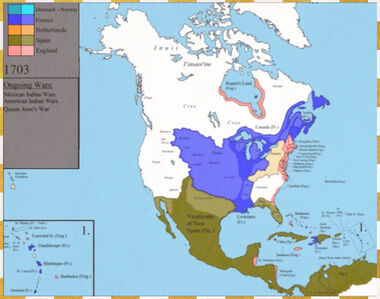
In North America, the accidents of history and facts of geography had combined to form a precarious balance of power between Spanish, French, and British interests. The quest for gold had brought the Spanish to Mexico. Their expansion was northwards to the west of the Rockies, into what are now New Mexico, Arizona and California, though the lands beyond Santa Fe were very thinly inhabited; for the most part occupancy meant a few forts and trading posts and a larger number of missions. Further north, the search for the Northwest Passage had brought the French along the valley of the St Lawrence and the Great Lakes, where they established a vigorous royal province based largely on trade in furs. While exploring through and around the Great Lakes, they began to move south down the Mississippi, Ohio, and Missouri rivers. By 1682, the French had reached the mouth of the great river, claiming the region as Louisiana, in honour of Louis XIV; New Orleans was not founded until 1718. New France was thus a huge area on the map, but outside the St Lawrence valley and Quebec it was only a scatter of strategically and commercially important forts and trading posts; there were barely 15,000 French in North America in all. Meanwhile, the British enjoyed the fertile Atlantic coastal fringe from Florida north to the Kennebec River, neatly confined by the Appalachian Mountains. Dutch New Amsterdam, lying exactly in the middle of this stretch, seemed to the British both an anomaly and an extremely desirable possession. When an English fleet arrived in 1664, the Dutch governor accepted the reality of the situation and surrenders the territory without a shot being fired; New Amsterdam was transformed without upheaval into New York. Continental North American in 1700 was organized as twelve colonies (a thirteenth, Georgia, appeared in 1732) in which lived some 400,000 settles. The middle colonies were the wealthiest, with much fertile soil that allowed the area to become a major exporter of wheat and other grains. Interest in the northern colonies had originally been awoken by the abundance of fishing, furs, and lumber, and, with generally rocky soil, colonists tended to move quickest into commence, shipbuilding, and craft-work. The southern colonies could produce tobacco, rice, and indigo, and from the start these imported the vast major of African slaves. Although British colonies, they soon became somewhat ethnically mixed, for after 1688 German, French Huguenot and Swiss emigrants had begun to arrive in appreciable numbers. Each colony had a slightly different governmental structure, but typically worked through some sort of representative assembly which spoke for its inhabitants to a royal governor appointed in London. Each of these three colonial groups engaged in periodic conflict with each other and with the original occupants of the land, the Native American Indians. But for the first two centuries of colonization these were little more than skirmishes. There seemed to be room for all. This began to change after 1689, when Britain and France were almost continually at war in Europe, starting with the War of the Grand Alliance (1688–97), and continuing with the Spanish War of Succession (1702-15), War of Austrian Succession (1740-48), and Seven Years’ War (1756-63). A more direct cause of conflict in North America derived from overlapping English and French interest in the disputed territory of the Ohio Valley, which eventually sparked the French and Indian War (1754-63) and dramatic change.
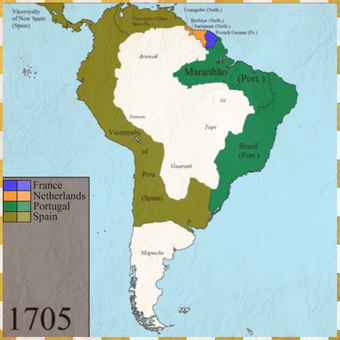
By contrast, South America would remain relatively tranquil, where Spanish and Portuguese colonies had few regions of overlapping interest, and the French, British, and Dutch settlements of the Guiana plains were economically trivial. The presence from the start of large pre-colonial native populations, as well as the nature of the occupying powers, did much to differentiate its colonialism from that of the north. Centuries of occupation by the Muslim Moors had accustomed the Spanish and Portuguese to the idea of living in a multiracial society; they did not share the concern for the "purity of their blood" which was shown by the English and French. There soon emerged in Latin America a population of mixed blood from interbreeding with both the indigenous peoples and with the growing population of black slaves, who had first been imported to work on the plantations of Brazil and mines of Bolivia in the 16th century. Nonetheless, these societies were stratified along racial lines. The dominant classes were always the Iberian-born and the creoles, persons of European blood born in the colonies; from there led downwards a blurred incline of increasing gradations of blood to the most oppressed, the pure Indians and black slaves. Meanwhile, Catholic missionaries were almost continuously at work converting the natives, and the Church was an important reinforcement for a thinly spread administrative apparatus of South America. One important development was the discovery of gold near Sao Paulo in 1695. This sparked the first gold rush in the history of the Americas, as prospectors swarmed to the region. By the time diamonds were discovered in large quantities in the same region in the 1720s, the centre of gravity in Brazil had decidedly moved to the south; the capital would move from Bahia in the north to Rio de Janeiro in 1763. In most of Latin America, isolated within the Spanish and Portuguese empires, the upheavals of the French Revolution in 1789 had little immediate effect, other than as a talking point of great topical interest. But the French islands in the Caribbean were more directly linked with these distant events. When a slave revolt in Haiti was rapidly successful under the first Latin American revolutionary hero, Toussaint L'Ouverture, no one could have predicted the domino effect that resulted; the Latin American Independence movement from 1809 to 1825.
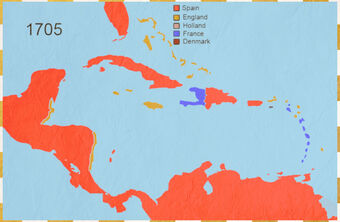
For all the spectacular outflow of bullion from Central and South America, and large-scale inflow of people to North America, it was the Caribbean islands that were of the greatest economic importance to Europe throughout most of the 17th-century. This importance rested on their agricultural produce, above all on sugar. Medieval man had sweetened his food with honey; by 1700 sugar was a European necessity. Tobacco, hardwood, and coffee were the other important products of the islands. The Caribbean was an area where the Spanish, French, Dutch and British colonial frontiers met, and one of the most frequent theatres where the great powers fought out their disputes. The smaller islands frequently changed hands, and Spain lost two large sections of the central Caribbean to her rivals in the late-17th-century; Jamaica to the British in 1655, and the western half of Hispaniola to the French in 1664 (modern-day Haiti). The area was long prey to disorder, and there were great prizes to be won. Not surprisingly, it became the classical and, indeed legendary hunting-ground of pirates, whose final heyday came in 1710s and '20s.
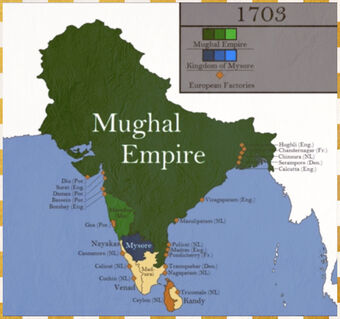
In the Far East, although the British would ultimately eclipsed the Dutch as a colonial power, in the short term the Anglo-Dutch Wars left the Netherlands with a stronger position in the Indian Ocean, Indonesia, and South China Sea. When hostilities ceased after the Glorious Revolution of 1688, a deal between the two nations left the spice trade to the Dutch, and trade with India to the British East India Company. The rise of British power in India was very gradual. After the establishment of Fort St George at Madras in 1644, the acquisition of Bombay from the Portuguese in 1661 as a part of the dowry of Charles II’s queen, and establishment of Fort William at Calcutta in 1690, there was no further British penetration of India until the mid-18th-century. From these early footholds the British conducted a trade in cotton, silk, indigo dye, coffee, and tea, less glamorous than the Dutch spice trade, but one which grew in value and importance. It also changed their national habits as the establishment of coffee-houses in London showed, as well as a new national beverage that poet William Cowper would soon commemorate, "cups that cheer but not inebriate". These unremarkable beginnings on coastal India offered no clues to what would become a lengthy British presence on the subcontinent. During this time the main rivals of the British in India were not the Dutch or Portuguese, but the French who were similarly expanding in the region, having established themselves at Pondicherry in 1673. Military domination in India was unlikely to prove easy, as a defeat of the East India Company’s forces against the Moghul Empire in Child's War (1686-90) showed. Yet all preconceptions were to be changed by the dramatic collapse of the Moghuls after the death of the 8th emperor, Aurangzeb, in 1707. The consequences emerged slowly, but their total effect was that India dissolved into a collection of autonomous states with no paramount power. In retrospect it seems remarkable that neither Britain nor France took advantage for so long, and then moved only by hostility to one another during the Seven Years’ War (1756-73).
The Caribbean and the last Golden Age of Piracy[]
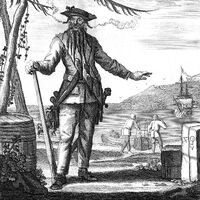
Edward Teach, more commonly known as Blackbeard, was active from 1716 to 1718 as perhaps the most notorious of the English-speaking pirate
Piracy, or thievery on the high seas, has popped up in many forms throughout history, from the Viking raiders of the 10th and 11th century, to the Barbary pirates of Muslim North Africa in the 16th century, and remains an issue today, particularly in the waters off the Somali coast. The Caribbean became the classical and, indeed legendary hunting-ground of pirates during the so-called Golden Age of Piracy, which lasted from roughly 1655 to 1726. This era produced many of the most infamous pirates of all time; Edward "Blackbeard" Teach, Henry Every, Henry Morgan, William "Captain" Kidd; Henry Jennings, Bartholomew "Black Bart" Roberts, Edward Low, Benjamin Hornigold, Charles Vane, "Calico Jack" Rackham, Anne Bonny, and Mary Read. Conditions were just right for piracy to boom. Firstly, there were ships full of valuable cargo, at a time of growing wealth and trade for all the nations who controlled territory in the Americas. Secondly, the Caribbean was an area where the Spanish, French, Dutch and British colonial frontiers met, and due to a high degree of tension among the colonial powers, most were more concerned with engaging each other than pirates; the region was long prey to disorder and little or no law. And finally, there were thousands of experienced sailors, many of whom had been "press ganged" into service in European navies, where the wages well low and unreliable, and conditions abominable. Comparatively, life on a pirate ship was a better and freer existence; pirates were extremely diligent about sharing the loot fairly, and, though punishments could be severe, they were rarely needless. Pirate crews came from every maritime country of Europe, and a good number of sailors were Africans. Privateers, licensed by a government to attack enemy towns or shipping during times of war, had flourished in the Caribbean since at least the 1520s, pioneered by French buccaneer like Pierre Le Grand. After the British captured Jamaica from Spain in 1655, they freely granted privateering commissions to the pirates who had established themselves on Tortuga, off Haiti. The aftermath of the War of Spanish Succession saw the last large resurgence of piracy. Thousands of able-bodied sailors left unemployed by the end of the war in 1714 turned en masse to piracy as a way to make ends meet. However, this same time period saw a changing attitude towards piracy from the great powers. The war had left the participants with unprecedented levels of debt, and in the aftermath the European great powers all saw peace as in their national interest; Europe enjoyed 25-years of relative peace until the War of Austrian Succession. In 1715, Henry Jennings and his pirate cohorts launched a successful raid on Spaniards trying to recover gold from a sunken treasure galleon off Florida. Contrary to their expectations, the British governor of Jamaica refused to allow them to spend their loot on his island. With Kingston and the declining Tortuga closed to them, this nucleus of mostly British ex-privateers founded a new pirate base at Nassau, on the island of New Providence in the Bahamas, which had been abandoned during the war. Until the arrival of a new governor, Nassau was controlled these pirates and their many recruits. In 1718, European nations decided to put an end to the pirate plague, bolstering their navies in the region, and commissioning pirate hunters, with the British appointing Woodes Rogers, a tough former privateer, as governor of Jamaica. The most effective weapon, however, was royal pardons. Some who took the pardon soon returned to piracy, like Blackbeard or Charles Vane, but most stayed legit. By the late-1720s, piracy continued, but was not nearly as bad a problem. Although some of the details have been romanticized, the effect upon popular culture of the Golden Age of Piracy can hardly be overstated, with such literary works as Robert Louis Stevenson’s Treasure Island (1881).
European Balance of Power[]

Marianne and Britannia, the national personification of France and Britain.
In the 18th century, the major European powers - France, Britain, Prussia, Austria, Russia - undoubtedly existed within the so-called European balance of power; constantly shifting alliances to prevent the hegemony of one nation or alliance. The two leading great European powers, France and Britain, were invariably on opposing sides of such alliances. Yet for a time in the aftermath of the War of the Spanish Succession, they often acted in a somewhat uneasy alliance, both seeing peace as in their national interest, with their national economies in a perilous state. When Louis XIV died in 1715, the French throne was left to his five-year-old great-grandson, Louis XV (1715-74). The French empire, though starting late compared to other Atlantic powers, was now the leading colonial rival to Britain, but after twenty-five years of almost continuous warfare, the nation's finances were now precariously close to bankruptcy. This was the era of financial experimentation in order to repair the national finances. The French regency was persuaded to gamble on a public-private partnership, but the Mississippi Bubble burst in 1720 leaving many people financially ruined and a lasting distrust of national banks; not until 1800 was the Banque de France finally established by Napoleon, long after the same step had been taken in other European countries. The same phenomenon was occurring across the Channel in Britain, where the shares of the South Sea Bubble had an equally irresistible allure to speculative investors; as many fortunes were made on the way up as were lost on the way down. However by the 1740s, with more aggressive factions in power in Britain and France, both embroiled themselves in the War of Austrian Succession. Most of the direct clashes were at sea, and in their overseas territories. The British navy blockaded the harbours of France, and harassed French merchant fleets en route for the West Indies or India. In 1745, the British seize the French Louisbourg in Canada, and in 1746, the French occupied British Madras in India; both were returned in the Treaty of Aix-la-Chapelle. Yet the war had only postponed an inevitable colonial conflict between Europe's leading powers less than a decade later; the Seven Years' War.
In the struggle to become the dominant naval power in Europe, the British would have distinct advantages. Britain enjoyed a long period of political stability after the Glorious Revolution. The ability of parliament to implement gradual reform, albeit often with great reluctance, would allow Britain to avoid the kind of dramatic revolutions that would rock Europe in the decades to come, beginning with the French Revolution. Britain's political stability brought economic prosperity, so that she could recover in years from wars, while France took decades, and Spain and Holland would be unable to reverse their military and economic decline. Meanwhile although Britain feared one nation or alliance achieving hegemony on continental Europe, she was able to keep herself aloof from direct involvement in continental conflicts, a luxury not available to the French; even in the Napoleonic Wars, Britain's involvement was peripheral. Meanwhile, she focused her attention on using wars as a pretext to wrestle colonial holdings from her rivals. Her allies were less than impressed with her often lacklustre support in continental conflicts, and she would find few allies in her time of need, during the American War of Independence.

